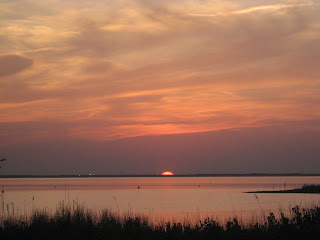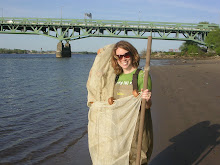 It’s the official start of summer and the longest day of the year. It is also the date of the Summer Solstice walk, one of the American Littoral Society’s many great traditions. Twenty five people joined Littoral Society and park staff for an evening stroll around the Hook last night. On our way to North Beach we checked out the Sandy Hook light house and the old batteries and learned a bit of Sandy Hook’s history. Additionally, Botany Bill and other Littoral Society folks pointed out some of Sandy Hook’s many plants to the group. We were also able to spot some of Sandy Hook’s resident birds including great egret, eastern towhee, osprey, cat bird, and black crowned night heron.
It’s the official start of summer and the longest day of the year. It is also the date of the Summer Solstice walk, one of the American Littoral Society’s many great traditions. Twenty five people joined Littoral Society and park staff for an evening stroll around the Hook last night. On our way to North Beach we checked out the Sandy Hook light house and the old batteries and learned a bit of Sandy Hook’s history. Additionally, Botany Bill and other Littoral Society folks pointed out some of Sandy Hook’s many plants to the group. We were also able to spot some of Sandy Hook’s resident birds including great egret, eastern towhee, osprey, cat bird, and black crowned night heron.
The timing was perfect; the sun had set as we arrived at the North Beach pavilion and it was just dark enough to see the New York City lights twinkling across the ocean. As we gazed out at the water many people asked great questions, testing our knowledge about Sandy Hook and the littoral zone. The Solstice Walk has been might favorite event thus far. It didn’t quite feel like we were giving a tour, it was more like exploring and sharing stories with friends. It was educational yet very casual and a great way to get people to know us. Be sure to join us next year!
Littorally Yours,
Stevie

 The American Littoral Society brings 12 high school students from Camden and Newark out to Sedge Island every year. It’s a small island in Barnegat bay off the coast of Island Beach State Park. The students leave the urban environment for three days and are completely immersed in nature and the serenity of the salt marsh. No phones, no ipods, and nothing to watch at night but the setting sun. The days are spent kayaking, fishing, clamming, and exploring the littoral zone. Students not only learn about the
The American Littoral Society brings 12 high school students from Camden and Newark out to Sedge Island every year. It’s a small island in Barnegat bay off the coast of Island Beach State Park. The students leave the urban environment for three days and are completely immersed in nature and the serenity of the salt marsh. No phones, no ipods, and nothing to watch at night but the setting sun. The days are spent kayaking, fishing, clamming, and exploring the littoral zone. Students not only learn about the 



